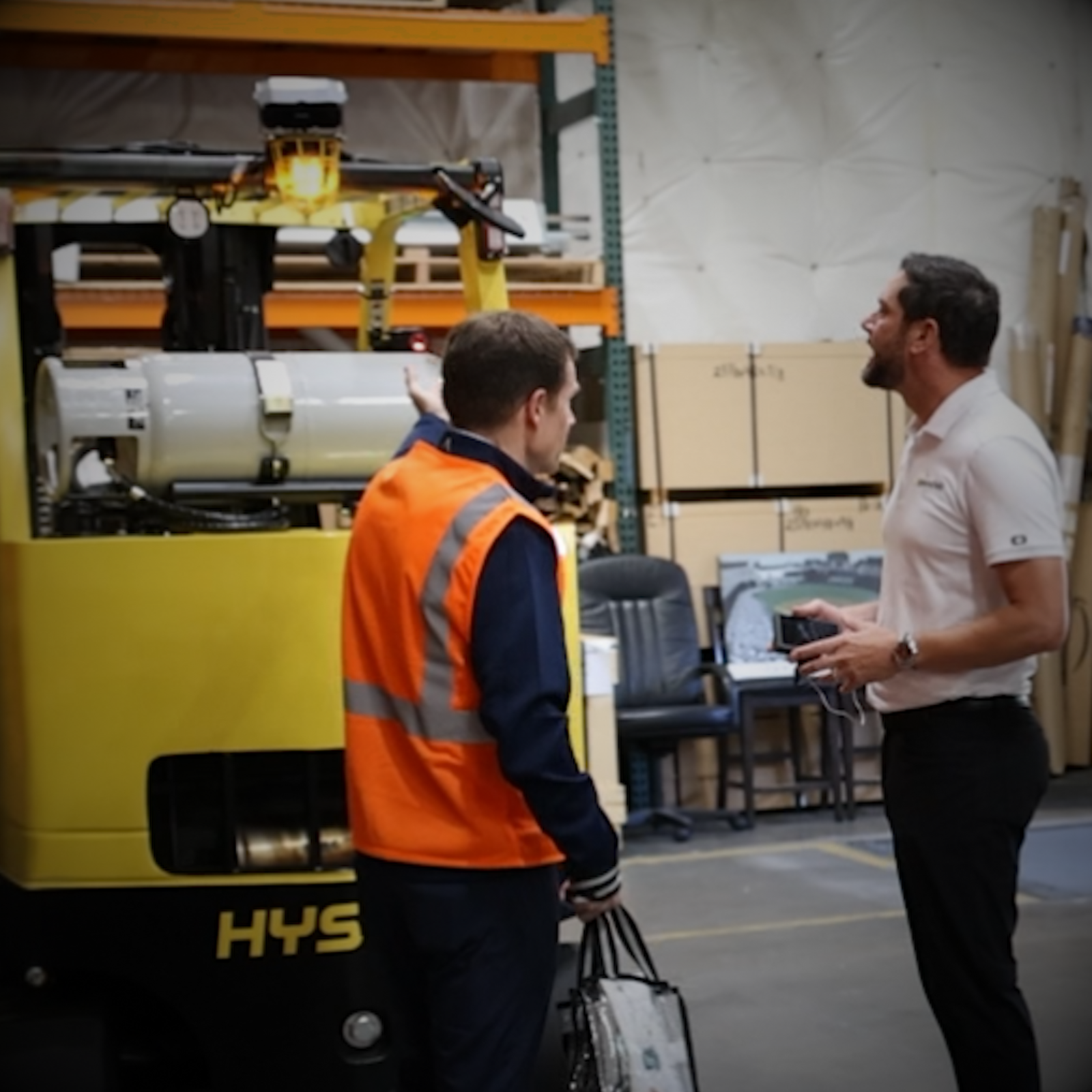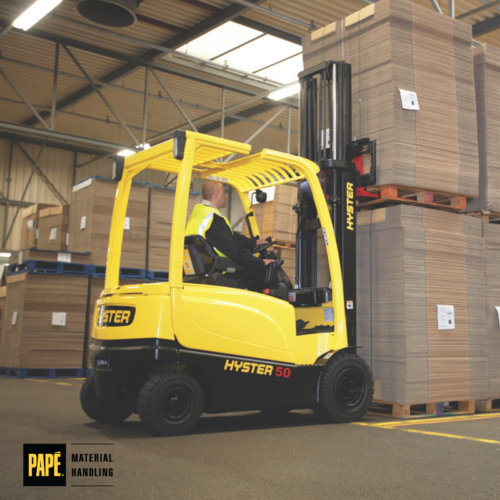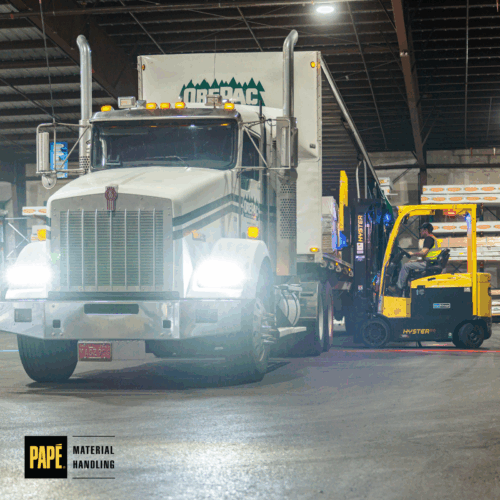In warehouses where people and machines operate in close quarters, pedestrian safety is a critical concern. At the recent PMH Forklift Safety event in Seattle, attendees witnessed firsthand how technology is stepping up to protect workers. One standout innovation was the Hyster Pedestrian Awareness Camera System, presented by TJ Ryals of Speedshield Technologies.
This wireless forklift system represents a major leap forward in accident prevention with its smarter, more human-aware approach to pedestrian detection. Designed to retrofit easily into existing fleets and requiring only very limited training, the system is positioned to redefine warehouse safety standards throughout the industry.
Beyond Object Detection: Smarter Vision for Safer Operations
While previous safety systems have focused on detecting all nearby objects, the Pedestrian Awareness Camera System goes further. It’s purpose-built to recognize pedestrians specifically, ignoring inanimate obstacles to minimize false starts. It uses stereoscopic vision (with two lenses, mimicking human vision) combined with AI-trained modeling to detect people, even when they are partially obscured or crouching low.
“We’ve trained the AI model to understand what a pedestrian is,” Ryals explains. “A hand’s connected to an arm, an arm’s connected to a body…We don’t have to see a full body to alert and let you know that a pedestrian is within proximity of the equipment.”
Further, this ability to detect occluded figures—those not fully visible—is essential in fast-paced and dynamic environments like a busy warehouse where workers may be crouching, reaching, or moving between equipment.
A Retrofittable Safety Upgrade for Mixed Fleets
One of the biggest challenges of warehouse operations is the wide diversity of equipment in use—new, old, large, small. The Hyster system solves that with a flexible, retrofittable design. Whether your fleet is brand new or has aging units, this camera system can be installed quickly and effectively across the board.
“This can be retrofitted in the field, which is really neat because very few operations have all brand new fleets,” says Ryals. “It installs in well under an hour, and I can usually train someone to use it in about five minutes.”
The system runs on existing power sources—so no additional inverter needed—and supports plug-and-play setup using the strobe light connector. WIth built-in inertial measurement unit (IMU) sensors, it knows when the forklift is in motion and only activates alerts when necessary, reducing noise and helping operators trust the system’s accuracy.
Visual + Audible Alerts Without Screen Distractions
Instead of relying on small onboard screens, the system uses a remote-mounted operator interface to provide peripheral alerts. This approach avoids the risky behavior of operators diverting attention from their current task to interpret on-screen information.
“There’s very little context you can get out of someone 16 feet away on a five-inch screen,” says Ryals. “We’ve already done the complex part—we told you a pedestrian is there. You just need to stay focused and keep your eyes on the task.”
The alert system combines audio and visual cues to communicate risk without overwhelming operators. It’s fully configurable, including voice or tonal outputs, volume settings up to 100 dB, and proximity zones. Typically, alerts are spaced every 7–8 seconds to maintain operator awareness without creating alert fatigue.
Designed for Contextual Awareness, Not Mere Alarms
The system isn’t merely about detecting pedestrians, however; it’s about understanding context. Whether someone is walking toward a forklift or crouching to grab a package, the AI has been trained to distinguish normal operating behavior from potentially dangerous proximity.
The camera unit processes data locally (edge computing), so nothing is sent to the cloud—a major benefit for facilities with union environments or GDPR compliance concerns. And while pedestrian awareness is currently the primary focus, Speedshield hints at future capabilities like near-miss analytics and zone monitoring, offering even deeper operational insights.
“There’s going to be future capability to show how many people came into the zone, how long they were there, what proximity range they were in,” Ryals explains. “That gives the safety manager additional KPI data to change operational flows.”
Compatibility and Scalability
The Hyster Pedestrian Awareness Camera System can support up to eight cameras on a single vehicle, although standard forklifts typically only require one to four. For more complex equipment like container handlers, the additional coverage ensures full 360-degree visibility.
Whether operating indoors under fluorescent lighting or outside near garage doors, the system is built with industrial sensors rated IP67, meaning they’re dust-tight and water-resistant. That makes it an ideal solution for facilities with varied environments.
Safety Through Consistency
By standardizing safety systems across all equipment—regardless of age or manufacturer—warehouses can achieve consistency in training and operation. The result is a safer workplace not just because of the improved equipment, but also because the operators develop trust in the tools at their disposal.
“Safety comes from consistency,” explains Ryals. “Having the same safety solution on all of your equipment adds value.”
A System That Gets Smarter Over Time
Each camera is a fully self-contained processing unit, and updates to the AI model are easily applied by scanning a QR code on the device. Speedshield typically releases updates every three to six months, ensuring that customers benefit from ongoing improvements without needing to overhaul their hardware.
Final Thoughts: Safety That’s Simple, Smart, and Scalable
The Hyster Pedestrian Camera System is more than just a forklift camera system—it’s a forklift collision avoidance system purpose-built for real-world warehouses. With retrofit capability, intuitive setup, and smart AI-driven pedestrian detection, it tackles some of the biggest pain points in forklift safety today.
For purchasing managers, safety officers, and fleet supervisors looking to improve worker protection and reduce incident rates, this system offers a compelling path forward. As Ryals puts it with a touch of humor and insight, “You can replace parts, not body parts.”
Ready to learn more about how this innovative system can help your operation? Speak with your rep to learn more.







